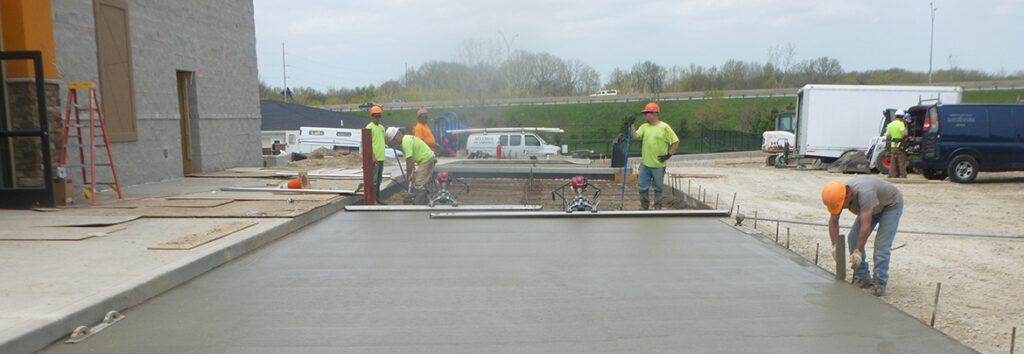Concrete is a durable and versatile building material commonly used for various construction
projects, including foundations, driveways, patios, and more. However, one of the most common
issues faced by concrete structures is the development of cracks. These cracks can be
unsightly and, in severe cases, compromise the structural integrity of the concrete slab. In this
article, we will explore strategies to prevent cracks in your concrete slab, ensuring the longevity
and aesthetic appeal of your concrete surfaces.

Understanding the Causes of Concrete Cracks
Before delving into prevention strategies, it’s essential to understand the various factors that can lead to cracks in concrete slabs. Cracks in concrete can result from a combination of the
following:
- Corrosion: Concrete structures can suffer from corrosion when exposed to harsh
environmental conditions, especially in coastal regions with high salt content in the air. This
corrosion can weaken the concrete, leading to cracks. - Chemical Exposure: Contact with corrosive chemicals or pollutants can deteriorate the integrity of concrete, making it prone to cracking.
- Design Flaws: Inadequate structural design, such as improper load distribution or
insufficient expansion joints, can create stress points in the concrete, ultimately resulting in
cracks. - Water Infiltration: When water seeps into the concrete through cracks or poorly sealed
joints, it can freeze and expand during cold temperatures, exerting pressure on the concrete
and causing it to crack further. - Aging: Over time, concrete naturally ages and may develop cracks and signs of wear,
especially without proper maintenance and repair.
Preventive Measures to Avoid Concrete Cracks
Proper Mix Design
Start with the right concrete mix. Consult with a professional or follow local building codes to
ensure that you’re using the correct mix for your specific project. Proper mix design can reduce
the risk of cracking.
Reinforcement
For larger concrete slabs, like those in foundations or driveways, consider using steel rebar or
wire mesh to reinforce the concrete. Reinforcement can help distribute the load and minimize
cracking.
Control Joints
Introduce control joints in the concrete slab. These are pre-planned, weakened areas that
encourage cracks to form in a controlled manner. Control joints help reduce the likelihood of
random, unsightly cracks. The spacing and depth of control joints should be determined based
on the slab’s dimensions and anticipated stresses.
Adequate Curing
Proper curing is essential to prevent cracking. This involves keeping the concrete moist for an
extended period, typically for at least seven days. Curing prevents the concrete from drying out
too quickly, reducing the potential for shrinkage cracks.
Minimize Water Content
Excess water in the concrete mix can weaken the final product. Ensure that your concrete mix
contains only the necessary amount of water for workability. Excess water can lead to shrinkage
cracking as it evaporates during the curing process.
Avoid Rapid Drying
Protect the concrete from rapid drying, especially in hot and windy conditions. Sun and wind can
accelerate the evaporation of moisture from the surface, which can lead to cracks. Use curing
compounds, wet burlap, or plastic sheeting to slow down the curing process.
Proper Subgrade Preparation
Proper subgrade preparation is crucial to avoid settlement and soil-related cracking. Ensure that
the subgrade is well-compacted, adequately drained, and free from organic materials. Proper
subgrade preparation prevents uneven settlement and soil movement.
Expansion Joints
In addition to control joints, consider incorporating expansion joints. These joints accommodate
concrete expansion and contraction due to temperature fluctuations, minimizing stress-induced
cracks.
Proper Placement Techniques
When pouring concrete, use proper placement techniques to minimize the risk of cracks.
Vibrating the concrete to eliminate air pockets and consolidating it evenly can help ensure a
more structurally sound surface.
Regular Maintenance
Once your concrete slab is in place, ongoing maintenance is crucial. Keep the surface clean,
and free from debris, and apply sealants as needed to protect against moisture penetration and
freeze-thaw cycles.
Conclusion
Preventing cracks in your concrete slab is a combination of proper planning, design, and careful
execution. By understanding the factors that contribute to cracking and implementing preventive
measures such as reinforcement, control joints, and proper curing, you can significantly reduce
the risk of cracks in your concrete surfaces. Remember that timely maintenance and vigilance
are also essential to ensuring the long-lasting beauty and durability of your concrete slabs. With
the right approach, you can enjoy your concrete surfaces without the worry of unsightly or
structurally compromising cracks.

